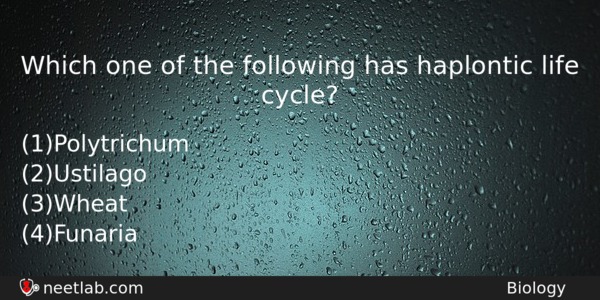| ⇦ | 
| ⇨ |
Which one of the following has haplontic life cycle?
Options
(a) Polytrichum
(b) Ustilago
(c) Wheat
(d) Funaria
Correct Answer:
Ustilago
Explanation:
Ustilago has a haplontic life cycle. This is a simplest and most primitive type of life cycle. The other pattern of life-cycle have originated from this type. This type is found in all Chlorophyceae. In such cases the somatic phase (plant) is haploid (Gametophyte) while the diploid phase (Sporophyte) is represented by zygote. During germination the zygote (2n) divides meiotically producing haploid (n) zoospores, which develop into individual plant. Here the unicellular or filamentous gametophyte (n) alternates with one-celled zygote or sporophyte (2n). The haploid filamentous plants are known as haploid which reproduce asexually by zoospores or aplanospores producing the individals like parents.
Related Questions: - R.Q (Respiratory quotient ) is infinite in
- Gout disorder happens due to accumalation of which joints
- Cytokinin synthesis is maximum in
- Steps of respiration are controlled by
- HIV decreases natural immunity of body by
Question Type: Memory
(964)
Difficulty Level: Easy
(1008)
Topics: Plant and Animal Kingdom
(295)
Subject: Biology
(4253)
Important MCQs Based on Medical Entrance Examinations To Improve Your NEET Score
- R.Q (Respiratory quotient ) is infinite in
- Gout disorder happens due to accumalation of which joints
- Cytokinin synthesis is maximum in
- Steps of respiration are controlled by
- HIV decreases natural immunity of body by
Question Type: Memory (964)
Difficulty Level: Easy (1008)
Topics: Plant and Animal Kingdom (295)
Subject: Biology (4253)
Important MCQs Based on Medical Entrance Examinations To Improve Your NEET Score
18000+ students are using NEETLab to improve their score. What about you?
Solve Previous Year MCQs, Mock Tests, Topicwise Practice Tests, Identify Weak Topics, Formula Flash cards and much more is available in NEETLab Android App to improve your NEET score.
Share this page with your friends

Leave a Reply